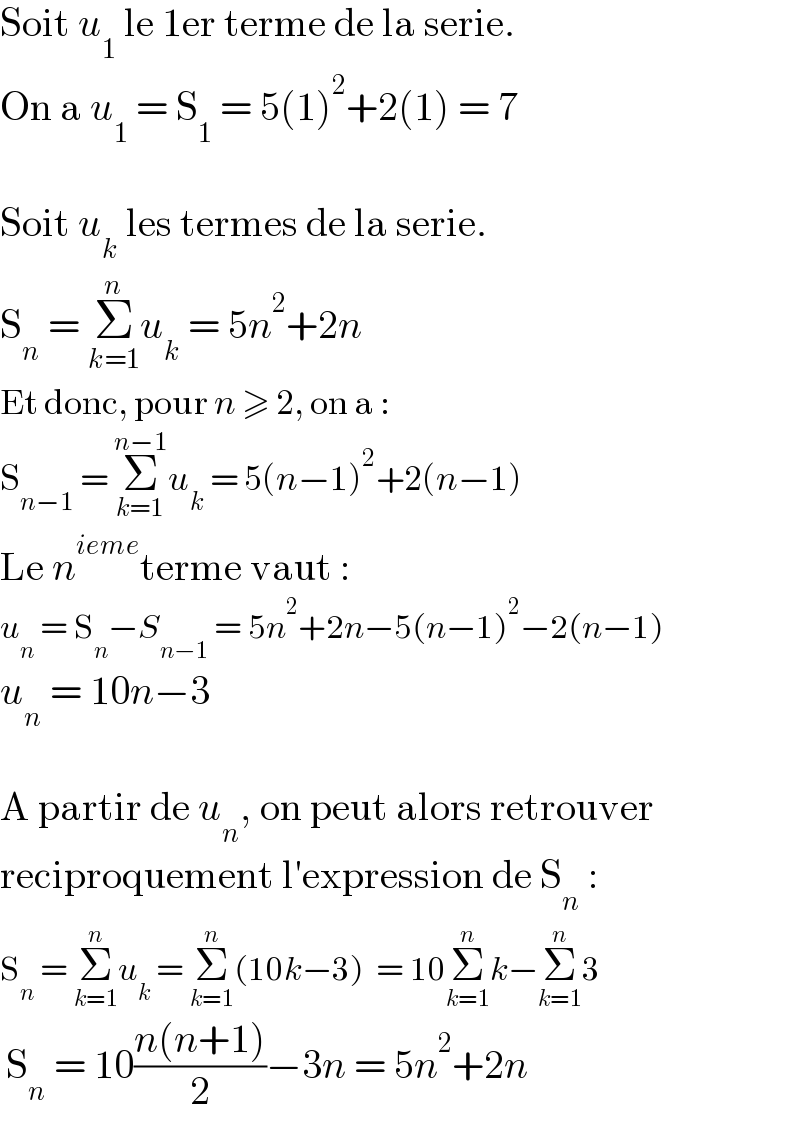Question Number 147988 by puissant last updated on 24/Jul/21

$$\mathrm{La}\:\mathrm{somme}\:\mathrm{des}\:\mathrm{n}\:\mathrm{premiers}\:\mathrm{termes}\:\mathrm{d}'\mathrm{une} \\ $$$$\mathrm{s}\acute {\mathrm{e}rie}\:\mathrm{est}\:\mathrm{donn}\acute {\mathrm{e}}\:\mathrm{par}\:\mathrm{S}_{\mathrm{n}} =\mathrm{5n}^{\mathrm{2}} +\mathrm{2n}\:\mathrm{le}\: \\ $$$$\mathrm{n}−\mathrm{ieme}\:\mathrm{terme}\:\mathrm{de}\:\mathrm{cette}\:\mathrm{serie}\:\mathrm{est}: \\ $$
Answered by Olaf_Thorendsen last updated on 24/Jul/21

$$\mathrm{Soit}\:{u}_{\mathrm{1}} \:\mathrm{le}\:\mathrm{1er}\:\mathrm{terme}\:\mathrm{de}\:\mathrm{la}\:\mathrm{serie}. \\ $$$$\mathrm{On}\:\mathrm{a}\:{u}_{\mathrm{1}} \:=\:\mathrm{S}_{\mathrm{1}} \:=\:\mathrm{5}\left(\mathrm{1}\right)^{\mathrm{2}} +\mathrm{2}\left(\mathrm{1}\right)\:=\:\mathrm{7} \\ $$$$ \\ $$$$\mathrm{Soit}\:{u}_{{k}} \:\mathrm{les}\:\mathrm{termes}\:\mathrm{de}\:\mathrm{la}\:\mathrm{serie}. \\ $$$$\mathrm{S}_{{n}} \:=\:\underset{{k}=\mathrm{1}} {\overset{{n}} {\sum}}{u}_{{k}} \:=\:\mathrm{5}{n}^{\mathrm{2}} +\mathrm{2}{n} \\ $$$$\mathrm{Et}\:\mathrm{donc},\:\mathrm{pour}\:{n}\:\geqslant\:\mathrm{2},\:\mathrm{on}\:\mathrm{a}\:: \\ $$$$\mathrm{S}_{{n}−\mathrm{1}} \:=\:\underset{{k}=\mathrm{1}} {\overset{{n}−\mathrm{1}} {\sum}}{u}_{{k}} \:=\:\mathrm{5}\left({n}−\mathrm{1}\right)^{\mathrm{2}} +\mathrm{2}\left({n}−\mathrm{1}\right) \\ $$$$\mathrm{Le}\:{n}^{{ieme}} \mathrm{terme}\:\mathrm{vaut}\:: \\ $$$${u}_{{n}} \:=\:\mathrm{S}_{{n}} −{S}_{{n}−\mathrm{1}} \:=\:\mathrm{5}{n}^{\mathrm{2}} +\mathrm{2}{n}−\mathrm{5}\left({n}−\mathrm{1}\right)^{\mathrm{2}} −\mathrm{2}\left({n}−\mathrm{1}\right) \\ $$$${u}_{{n}} \:=\:\mathrm{10}{n}−\mathrm{3} \\ $$$$ \\ $$$$\mathrm{A}\:\mathrm{partir}\:\mathrm{de}\:{u}_{{n}} ,\:\mathrm{on}\:\mathrm{peut}\:\mathrm{alors}\:\mathrm{retrouver} \\ $$$$\mathrm{reciproquement}\:\mathrm{l}'\mathrm{expression}\:\mathrm{de}\:\mathrm{S}_{{n}} \:: \\ $$$$\mathrm{S}_{{n}} \:=\:\underset{{k}=\mathrm{1}} {\overset{{n}} {\sum}}{u}_{{k}} \:=\:\underset{{k}=\mathrm{1}} {\overset{{n}} {\sum}}\left(\mathrm{10}{k}−\mathrm{3}\right)\:\:=\:\mathrm{10}\underset{{k}=\mathrm{1}} {\overset{{n}} {\sum}}{k}−\underset{{k}=\mathrm{1}} {\overset{{n}} {\sum}}\mathrm{3} \\ $$$$\:\mathrm{S}_{{n}} \:=\:\mathrm{10}\frac{{n}\left({n}+\mathrm{1}\right)}{\mathrm{2}}−\mathrm{3}{n}\:=\:\mathrm{5}{n}^{\mathrm{2}} +\mathrm{2}{n} \\ $$
